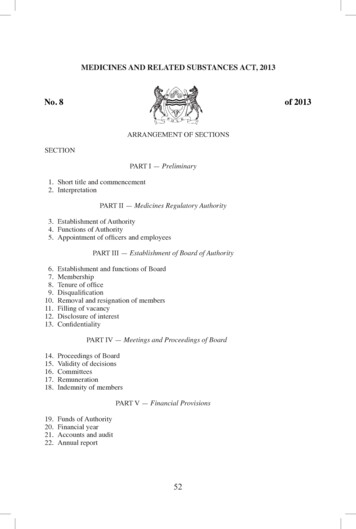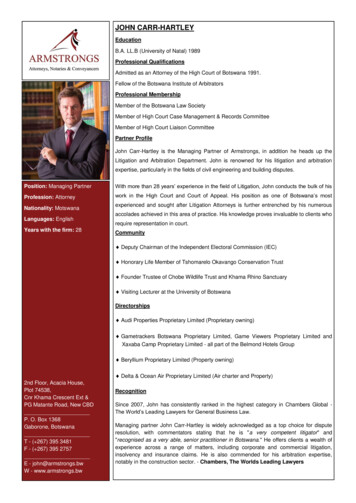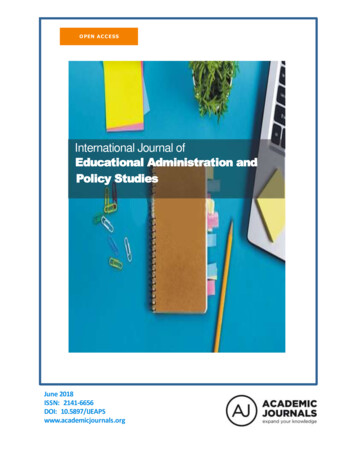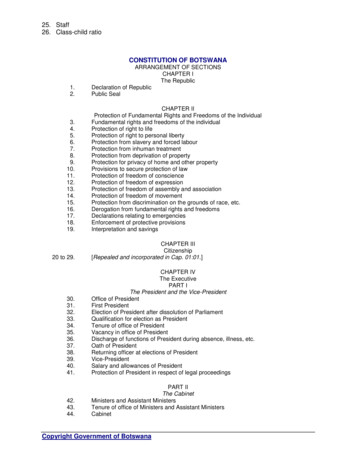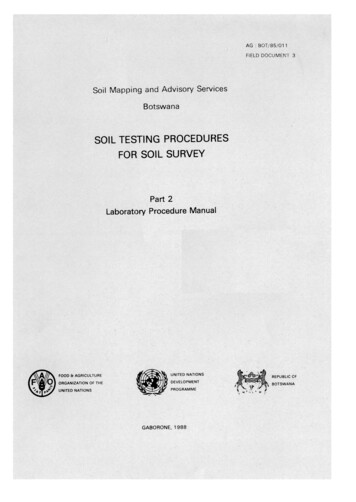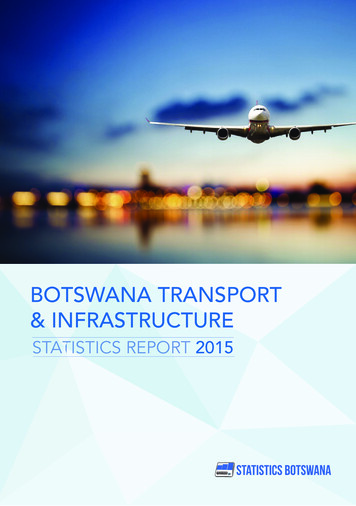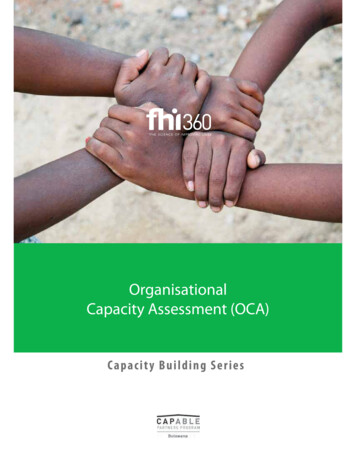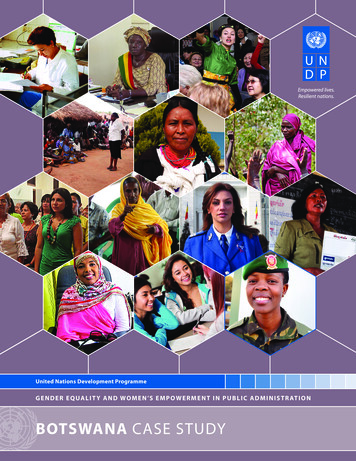
Transcription
United Nations Development ProgrammeG E N D E R E Q UA L I T Y A N D W O M E N ’S E M P O W E R M E N T I N P U B L I C A D M I N I S T R AT I O NBOTSWANA CASE STUDY
TABLE OF CONTENTSKEY FACTS. 3ACKNOWLEDGEMENTS. 4EXECUTIVE SUMMARY. 5METHODOLOGY. 7CONTEXT. 9Socio-economic and political context. 9Public Administration context. 10Gender equality context. 11WOMEN’S PARTICIPATION IN PUBLIC ADMINISTRATION. 15Overall numbers. 15Sector segregation. 15Vertical segregation. 15Women’s high participation in public administration: possible factors. 16POLICY AND IMPLEMENTATION REVIEW. 18Constitution. 18Gender equality policy and legislation. 18Public administration statutes and policies. 21Life-work enabling policies. 22Challenges in implementing policy and obstacles facing women. 28Good practices. 32SPECIFIC INITIATIVES. 33National. 33UNDP and other international agencies. 36KEY ISSUES, CHALLENGES AND GOOD PRACTICES. 37Challenges. 37Good practices. 37RECOMMENDATIONS. 38Recommendations for Policy. 38CONCLUSIONS. 42Botswana Case Study 1
TABLE OF CONTENTSANNEX 1: TABLES. 44Table 1: Gender Statistics Botswana 2011. 44Table 2: Category and Number of Key respondents. 46Table 3: Employees by Ministry and Gender. 47Table 4: Employees by Job Grade and Gender. 48ANNEX 2: ABBREVIATIONS AND ACRONYMS . 49ANNEX 3: BIBLIOGRAPHY. 50List of Statutes and Policies. 54Newspaper Articles. 55ANNEX 4: LIST OF KEY INFORMANTS INTERVIEWED. 562 Gender Equality and Women’s Empowerment in Public Administration
KEY FACTSKEY FACTSHUMAN DEVELOPMENTINDEX RANKING118 out of 1851GENDER INEQUALITYINDEX102 out of 1462TRANSPARENCYINTERNATIONALRANKING32 out of 182 countries in 2011 (Corruption Perceptions Index)% MEN ANDWOMEN IN CENTRALGOVERNMENT% MEN AND WOMENIN SUBNATIONALGOVERNMENT/LOCALAUTHORITIESAFFIRMATIVE ACTIONNEED TO KNOWWomen: 51%Men: 49%Women: 47.1%Men: 52.9%No affirmative action policies and laws in thepublic administrationPolicies on recruitment, retention, promotion, training,and transfers are gender-neutralThe policy framework that guides the operationsof public administration system is gender-neutral1212Human Development Index Ranking 2011. Accessed from http://hdr.undp.org/en/data/trends, 13/03/2012.Gender Inequality Index and related indicators. Accessed from http://hdr.undp.org/en/media/HDR 2011 ENTable4.pdf, 13/03/2012.Botswana Case Study 3
ACKNOWLEDGEMENTSACKNOWLEDGEMENTSUNDP would like to thank all colleagues, key respondents and interviewees, and national and international partners, who contributed their knowledge and time towards the realization of this document.The lead author is Tapologo Maundeni.Methodological guidance and substantive and technical inputs were provided by Suki Beavers (UNDP),Patrick Keuleers (UNDP), Noëlla Richard (UNDP) and Soma Chakrabarti Fezzardi (UNDP GEPA Initiative).Helpful research support and comments were also provided by Sarah Lisenbee and Emily Siu.Sincere thanks go to colleagues from the UNDP Regional Centre and the UNDP Country Office in Botswana, in particular Rebonyebatho Bonang Moaneng, for their invaluable support to this case study,both practical and technical.We also would like to thank the peer reviewers of this report for their useful feedback: RebonyebathoBonang Moaneng (UNDP), Auxilia Ponga (UNDP) and Dr. Pelotshweu Moepeng (The Botswana Institutefor Development Policy Analysis).This case study was written as part of the first phase of a cross-practice and cross-thematic Global UNDPInitiative on Gender Equality in Public Administration (UNDP GEPA Initiative), launched in 2011, underthe leadership of Winnie Byanyima and Geraldine Fraser-Moleketi.4 Gender Equality and Women’s Empowerment in Public Administration
EXECUTIVE SUMMARYEXECUTIVE SUMMARYBotswana is considered a middle-income country. The country has also enjoyed a stable democracysince 1996. Botswana is committed to upholding the rule of law and affords its citizens and all people inthe country ‘the protection and the enjoyment of freedoms and rights, without discrimination’ as provided for by the Constitution. The rapid spread of HIV/AIDS in Botswana has become a major threat tothe progress that the country has made in the area of economic and social development.3Women in Botswana constitute 52 percent of the country’s population.4 Within this population, thereare social differences depending on regional location, occupation, ethnicity, religious affiliation, andeducational attainment. For example, some women have attained high levels of education that haveenabled them to climb up the career ladder, and others have never been to school.5Prior to the UN declaration of the ‘Decade for Women’ (1975-1985), there was generally a lack of awareness about gender issues in Botswana.6 However, there were several positive developments that hadtaken place prior to 1985. These include the existence of groups such as Young Women Christian Association (YWCA) and Botswana Council on Women (BCW), which were implementing a wide range ofprogrammes for the advancement of women in Botswana as well as the accumulation of data on thesituation of women and the impact of development on them.With the declaration of the period 1975 to 1985 as the ‘Decade for Women’, women became more visible in social and economic development. There was a worldwide movement to highlight discriminationagainst women as well as their unequal access to income, employment and the enjoyment of individualfreedoms and human rights that were guaranteed in most national constitutions. During the decade forwomen, Botswana had no clearly defined policy or strategy for the advancement of women in society.‘However there was just sufficient understanding of the commitment to women’s advancement by the World body to encourage Botswana to set up a Women’s Affairs Unit in 1981.’ 7Recent statistics show that in 2009, women accounted for 45 percent of senior management positionsin the public service, up from 37 percent in 2005.8 Although these figures seem relatively high, it shouldbe noted that the highest positions/officers in the civil service such as permanent secretaries, deputypermanent secretaries and directors of departments9 are held largely by men.10 Middle managementin almost all departments is predominantly women; the lower levels of all departments are alsopredominantly women.113456Ntseane and Solo (2007).Central Statistics Office (2001).Women’s Affairs Department (1998).Women’s Affairs Division and The National Preparatory Committee for the Regional and World Conference onWomen, (1995).7 Women’s Affairs Division and The National Preparatory Committee for the Regional and World Conference onWomen (1995, p. 5).8 Republic of Botswana and United Nations (2010).9 These are not political appointments.10 See Table 1 in Annex 1 for this information.11 Women’s Affairs Department (2008).Botswana Case Study 5
EXECUTIVE SUMMARYIn the current parliament, women account for only 7 percent, down from 11 percent in the 1999-2004Parliament and 18 percent in the 1994-1999 Parliament.12 Only 20 percent of Botswana’s councillors arewomen and traditional leadership is another male dominated area, with only 9 percent of leadershippositions held by women.13 These rates are well below the Southern African Development Community(SADC) goal of parity representation. The over-representation of men in top policy making positionseffectively means that women are unable to contribute to policy making.Most initiatives to address gender equality in the country have focused on issues such as gender-basedviolence, HIV/AIDS and poverty and there is a gap in terms of gender equality in the public administration.Policy recommendations that could promote gender equality in public administration include:-- Systematic review of existing public administration laws and policies to ensure that they are gendersensitive and not just gender-neutral;-- Formulation of a gender equality and mainstreaming policy, including an affirmative action thatclearly specifies a commitment to achieving gender parity at all levels, including guidelines, principles, targets and redress mechanisms.Programming recommendations include:-- Sensitization campaigns to ensure all managers know their legal obligations and regional goals forparity representation in women’s leadership;-- Sensitization of public administration managers to address deeply rooted cultural stereotypes aboutwomen as leaders;-- Capacity-building support to high potential women to rapidly be promoted to senior positions,whilst respecting the principle of merit-based appointment;-- Capacity-building for gender focal points in ministries and local government;-- Improvement of women’s access to existing women’s empowerment programmes/training, capacitybuilding (e.g. workshops, seminars, etc.);-- Adoption of a comprehensive and proactive approach involving all stakeholders, including men. Thereis urgent need to establish a cross-cutting coordinating and monitoring mechanism that can periodically assess progress as well as recommend proactive and practical strategies. This could be in the formof a National Gender Policy-level commission established by act of Parliament with representationfrom central and local governments. There is also a need for a more active gender parliamentary committee to advocate and monitor the gender mainstreaming agenda. This committee will undertakeresearch, consult relevant stakeholders, and design a national strategy to change the status quo;-- Support to women’s networks within the public administration (PA), as they can contribute to policysolutions and identify key issues to be addressed;-- Support to NGOs to advocate for women’s empowerment, and consultation of those NGOs when PApolicies and laws are formulated or amended;-- Mobilization of the media to advocate for gender equality and women’s equal access to decisionmaking in all private and public spheres.12 Republic of Botswana and United Nations (2010).13 Republic of Botswana and United Nations (2010).6 Gender Equality and Women’s Empowerment in Public Administration
METHODOLOGYMETHODOLOGYData for the Botswana country case study was collected through desk research and key informant interviews to gather information on the following key questions:-- What is the current status of women’s representation in the public administration, and what are thepatterns and trends if any?-- To what extent does policy and implementation support gender equality in the public administration?-- What seems to be working, what is not working and why?A specific issue for Botswana was to understand what could explain the relatively high participationof women.A review of published and unpublished documents that focus on the socio-economic context, including, relevant cultural factors, gender equality, public administration, and gender equality in publicadministration in Botswana, gender-related key national legal and policy frameworks and reports onrelevant international conventions, initiatives on gender equality in Public Administration Reforms (PAR)at national or sub-national level, and interventions by UN agencies and other international organizations was done.14The second major source of information was in-depth interviews with key stakeholders. One–on-oneinterviews were held with officials of the following key government ministries, departments and committees between November 2011 and January 2012. Ministry of Local Government (MLG) Ministry of Finance and Development Planning (MFDP)15 Department of Women’s Affairs (WAD) in the Ministry of Labour and Home Affairs Department of Public Service Management (DPSM)16 Oversight agencies such as the office of the Ombudsperson, Caucus for Women in Politics Botswana Council of Non Governmental Organizations (BOCONGO)14 See Annex 3 for a list of documents that were reviewed.15 The MLG and MFDP have almost equal numbers of women and men in top decision-making positions, exceptin the highest cadre of Permanent Secretaries. The original intention was to include two ministries that havelow numbers of women who hold top decision-making positions, but this was not possible.16 According to the Women’s Affairs Department (2008), DPSM is the employing body of government employees.Botswana Case Study 7
METHODOLOGYMoreover, members of the University of Botswana’s Gender Policy and Programme Committee (GPPC),Botswana Network on Ethics Law and HIV/AIDS (BONELA), Emang Basadi17 as well as a representative ofone national18 parastatal-Local Enterprise Authority (LEA) participated in the interviews.Lastly, representatives from UNDP and other organizations were interviewed: SADC, UNAIDS, andFriedrich Ebert Foundation.19 Table 2 in Annex 1 presents information on the people who were keyinformants.17 Emang Basadi means ‘Stand up, women’. It is one of the oldest NGOs in the country that focuses on theempowerment of women.18 In Botswana, there are no subnational parastatals, only national ones.19 Friedrich Ebert Foundation is one of the few international donor organizations that still provide fundingto some organizations in Botswana. Most international donor agencies have stopped funding Botswana’sNGOs under the contention that the economy of Botswana is doing far much better than those of many developing countries.8 Gender Equality and Women’s Empowerment in Public Administration
CONTEXTCONTEXTThis section gives an overview of the socio-economic, cultural and gender equality context, as well askey issues in the public administration.SOCIO-ECONOMIC AND POLITICAL CONTEXTBotswana is one of the African countries that have enjoyed a stable democracy. Since independencein 1966, the country has held free elections every five years. Botswana has never experienced a civilwar or the civil strife that has characterized the political turf in many African countries. Therefore, thepeace and stability that prevails in the country in many ways provide a conducive environment for thepromotion of gender equality. Wars tend to disrupt the entire fabric of social, economic and community relations, creating a fragmented and disempowered society - an environment that violates humanrights.20 However, another aspect of this is that it tends to promote cultural conservatism, which worksagainst gender equality or any major change.21Botswana has made considerable progress economically as well as in the provision of social services.At Independence in 1966, the country was so poor that it could not even meet its recurrent budgetobligations, hence recurrent and development budgets depended heavily on foreign aid.22 The discovery of minerals in the late 1960s and early 1970s, combined with good economic management anddemocratic governance, contributed significantly to the country’s economic growth such that, by themid-1990s, Botswana was designated a middle-income country by the World Bank.23 On average, realGDP grew by 9 percent per annum between the years 1966 and 2006.24In addition, the government of Botswana is committed to upholding the rule of law and affording itscitizens and all people in the country “the protection and the enjoyment of the fundamental freedomsand rights that injure to the human race, without any distinction whatsoever, as provided for by theConstitution of Botswana”.25 This is an important foundation for the promotion of gender equality.Any person can go to the High Court and the Court of Appeal if he or she feels that his or her rights arebeing violated. There have been cases where the state was accused of violating the rights of certainpeople and the government proceeded to amend its laws accordingly. The case of the Attorney Generalof the Republic of Botswana vs. Unity Dow is an example of such a case.26 It resulted in the Governmentamending the Citizenship Act in 1995 to allow Botswana women married to spouses of foreign origin topass citizenship to their children as the case proposed that the law was discriminatory against women.2720212223242526Maundeni, T. (2010a).Maundeni, Z. (2008).Kapunda & Moffat, 2010.Kapunda & Moffat, 2010.Kapunda & Moffat, 2010.Ministry of Local Government, Lands and Housing (2001: 10).Dow, U. The Citizenship Case: The Attorney General of the Republic of Botswana vs Unity dow2.htm. Accessed on 8 May 2012.27 Dow, U. The Citizenship Case: The Attorney General of the Republic of Botswana vs Unity dow2.htm. Accessed on 8 May 2012.Botswana Case Study 9
CONTEXTBotswana’s positive political and policy context is well summarised by Hope (2002: 1) when hestates that:‘[ ] Botswana remains as an exceptional state in sub-Saharan Africa. It practices prudenteconomic management; it is a tolerant democracy with a penchant for good governance; itremains an apolitical and generally effective bureaucracy; it boasts an environment that isconducive to private investment and promotes market-oriented sustainable development;and it engenders macroeconomic stability [ ].’One important social aspect is that Botswana has been hard hit by the HIV pandemic. Existing literature28 shows that unlike males, females are at a higher risk of HIV/AIDS infection. Another issue thatconfronts Botswana is Gender-Based Violence (GBV). Research shows that three out of every five womenin Botswana has been subjected to one or more of the following forms of gender-based violence:assault; sexual harassment; sexual exploitation; severe beating; rape; incest; socio-economic abuse;verbal and emotional abuse, or even murder.29 They suffer this violence regardless of social class, ethnicbackground and age. Poverty is another challenge that confronts women.30PUBLIC ADMINISTRATION CONTEXTThis section briefly describes the public administration context in Botswana, including how it is organized, what has shaped it and what drives it, as well as how human resources management operates.Organization of the public serviceThe Public Service covers all the spheres of governance, such as political administration, public administration and law and justice administration. Each ministry appoints its own leadership team. There arealso numerous structures such as independent bodies and the DPSM manages the human resourceneeds of agencies and directorates such as the Ombudsman, National AIDS Coordinating Agency(NACA), Directorate on Corruption and Economic Crime (DCEC), Independent Electoral Commission(IEC) and other government establishments.The government of Botswana is the sole employer of all public service employees. Employment of government workers in the country is overseen by the Department of Public Service Management (DPSM),which was established in 1986.31 Prior to that, matters such as appointments, promotions, transfers anddisciplinary issues were handled by the Public Service Commission. As the human resource agency ofgovernment, DPSM is responsible for: Public service manpower planning, recruitment and development, grading and deployment Public service administration and management Public service performance and productivity improvement3228293031Republic of Botswana and United Nations (2010); Phaladze and Tlou (2001); Montsi, et al. (2001).Women’s Affairs Department - WAD (1999).Fako and Sechele (2010).Source: http://www.dpsm.gov.bw/index.php?option com content&view article&id 83&Itemid 29Accessed on 8 May 2012.32 Republic of Botswana Public Administration Country Profile. nts//un/unpan023251.pdf Accessed on 27 December 2011.10 Gender Equality and Women’s Empowerment in Public Administration
CONTEXTThis means that the DPSM is a very important actor in terms of the public administration, with a majorrole in how human resources issues and gender equality are treated. DPSM supports all 15 governmentministries and departments in human resource policy formulation, monitoring and evaluation and aswell as upholding ethical public service oriented values in line with the code of practice.33Key issues facing the public administrationThe public administration in Botswana is faced with a number of crucial issues, including diminishingfinancial resources. As is the case in many countries, Botswana’s PA system is impacted by the currentglobal recession. While many African countries have embarked on structural adjustment programmes(SAPs) since the 1980s Botswana has not engaged in such programmes. However, the Minister of Financeand Development Planning (the Honourable Mathambo) mentioned during his budget speech in January 2012 that, with effect from April 2012, each ministry should start to cut its spending by 5 percent.Moreover, the government has imposed a recruitment freeze unless absolutely necessary. This is likely tofurther limit opportunities to increase the number of women in the public administration at all levels.The second challenge that Botswana’s public administration is facing is declining productivity andgrowing indiscipline.34The third challenge that has confronted the civil service is HIV/AIDS. This issue was of great concernto the government as well as to BCSA. Consequently, in 2001, after consultations with BCSA, the government launched the Public Service Code of Conduct on HIV/AIDS in the workplace.35 One of theobjectives of the code was to articulate the public service’s position and practices as they relate to officers who are infected or affected by HIV/AIDS. The impact of the Public Service Code of Conduct on HIV/AIDS on gender equality in public administration is not known, since no rigorous evaluations have beenconducted. However, because the number of women who are infected by HIV in Botswana outweighsthat of men, it is hoped that the Code will help to address the HIV-related needs and circumstances ofboth men and women in the public administration.36GENDER EQUALITY CONTEXTPatriarchal societyBotswana is a patriarchal society, characterized by cultural norms, beliefs and practices that perpetuategender inequalities.37 For example, the Setswana language38 has proverbs that cast women in a negativelight, such as ‘ga di nke ke etelelwa ke manamagadi pele, di ka wela selomo – Banna ke baeteledipele ka tholego’. This literally translates to ‘A team of oxen is never led by females, otherwise the oxen will fall into aditch – men are natural leaders’. Proverbs like this encourage females to be submissive and weaken theirself-esteem and confidence.3933343536373839Interview with the Deputy Director of Human Resources at DPSM, February 13, 2012.Makgala, J. C. and Maundeni, Z. (2010).Makgala, J. C. and Maundeni, Z. (2010).Republic of Botswana and United Nations (2010).Maundeni, T. (2001).The mother-tongue of the majority of people in Botswana.Datla, et al (1998): Maundeni, T. (2001).Botswana Case Study 11
CONTEXTIndeed the popularity of the proverb that women should not lead is such that it has to a large extentresulted in women being excluded from positions of power.40 At the time of writing, only 11 percent ofchiefs were women.41 On a similar note, in 2012, the percentage of female members of parliament wasseven.42Gender patterns in access to educationCultural beliefs that females/women are minors and subordinate have played a role in shaping parents’views about the importance of education for male and female children. For example, from time immemorial, Botswana men have been migrating to South African mines, leaving women behind. Even whenmodern education was introduced in Botswana, males were the ones who were sent to school in largenumbers because the elders believed that females did not need education as they would soon get married and then be taken care of by their husbands.43This is important, as education is the most important foundation for entry and promotion in the jobmarket, including in the public administration with its special focus on merit-based human resourcespolicies. In an effort to redress inequalities of access to education, the government followed the recommendations of the Commission on Education in 1977 and adopted a policy of access to education forall irrespective of ethnicity, gender, location, disability, etc. The Ministry of Education has also passed are-entry policy that allows female students who have been affected by pregnancy to re-enter the schoolsystem. The policy reads thus:1. If a pupil becomes pregnant the parent or guardian of such a pupil shall be required to withdraw herfrom the school at which she is enrolled; and her admission to a school, which shall be other thanthat from which she was withdrawn, shall be at least one calendar year after cessation of pregnancyand subject to the written approval of the Minister.2. The parent or guardian of a pupil who is responsible for the pregnancy of another pupil shall berequired to withdraw him from the school and his return shall be subject to a written approval fromthe Minister.3. A pupil shall not be allowed to write an examination at school while she is pregnant.4. A pupil who was withdrawn from a school on account of her pregnancy shall not be allowed to writean examination at a school until at least six months after such pregnancy has ceased.The requirement that a pregnant pupil shall stay away from school for one year after the cessation ofpregnancy was discriminating against pregnant girls on the basis of their gender. Pregnant public administration employees are given three months of maternity leave because, under normal circumstances,medical practitioners determine this to be adequate for a person to recover from childbirth and relatedcomplications. Therefore, one may wonder why the policy stated that pregnant girls should stay away fromschool for one year.40 Somolekae (2000).41 Chiefs are traditional tribal authorities. The positions are hereditary and, from time immemorial, they werereserved for men only. A female chief could only be appointed when there was no male in the family.42 Republic of Botswana and United Nations (2010).43 Interview with the Dep
6 Women's Affairs Division and The National Preparatory Committee for the Regional and World Conference on Women, (1995). 7 Women's Affairs Division and The National Preparatory Committee for the Regional and World Conference on Women (1995, p. 5). 8 Republic of Botswana and United Nations (2010). 9 These are not political appointments.


